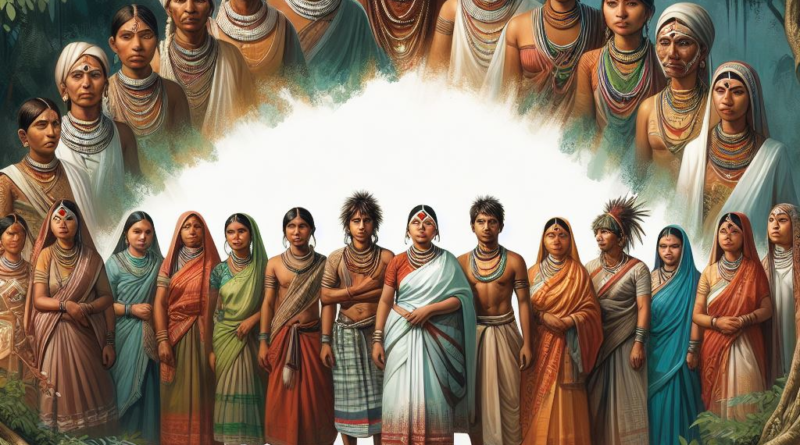About the Empowering India’s Tribal Communities| Ias Banenge
Context:
In recent times, India has witnessed remarkable progress across various sectors, including space exploration and technological innovation. However, amidst these advancements, the indigenous tribal communities within the nation confront numerous obstacles hindering their development and overall well-being. This raises a pressing need for collective endeavors to address their requirements and diminish prevailing socio-economic disparities.
Relevance:
GS-2
- Issues Related to SCs and STs
- Government Policies and Interventions
Mains Question:
There is an urgent need to bridge the gap between national development agendas and the harsh realities experienced by marginalised tribal communities. Analyse. (10 Marks, 150 Words).
READ MORE- Navigating the Legal and Ethical Implications of AI
Tribal Population in India:
- Following Africa, India hosts the second largest concentration of tribal population globally. According to the 2011 Census, tribal communities make up approximately 8.9% of India’s total population.
- The Census also reveals that Scheduled Tribes constitute 8.6% of the nation’s overall population and 11.3% of the rural population.
- Tribal communities comprise approximately 10 crore individuals distributed across different states.
- Despite their rich diversity in cultures, languages, and traditions, these communities share common experiences of marginalization and socio-economic gaps.
- Traditionally, they have maintained a harmonious relationship with nature, relying on age-old livelihood practices such as agriculture, hunting, and gathering.
Challenges Encountered:
- Despite endeavors to enhance educational accessibility, tribal communities continue to confront hurdles in achieving educational parity.
- The literacy rate among tribal populations stands at a concerning 59 percent, notably lower than the national average.
- Factors such as inadequate infrastructure, shortages of educators, and cultural barriers contribute to this educational disparity, perpetuating cycles of poverty.
- Tribal communities grapple with disproportionately high rates of malnutrition, affecting 39.5 percent of individuals, as reported by the National Family Health Survey.
- Additionally, prevalent diseases like Sickle Cell Disease (SCD) and thalassemia underscore the inadequate healthcare infrastructure and limited access to medical facilities in tribal regions.
- Long-standing land rights issues pose significant challenges for tribal communities, often leading to displacement due to development projects, natural disasters, and encroachment by the mainstream society. Violations of constitutional safeguards designed to protect tribal lands, such as the Panchayats (Extension to Scheduled Areas) Act (PESA), further compound their vulnerability.
- The economic development of tribal communities is hindered by limited access to markets, credit facilities, and technology, perpetuating cycles of poverty and dependency.
- Discrimination and exploitation are pervasive issues faced by tribal communities, both internally and in their interactions with mainstream society.
- Challenges such as human trafficking, wrongful imprisonment, and forced displacement underscore the vulnerability of tribal populations and emphasize the urgent need for legal protections and social support mechanisms.
Initiatives and Interventions:
- Efforts aimed at enhancing access to quality education and vocational training programs have the potential to elevate the employability and socio-economic status of tribal youth.
- Measures like establishing residential schools, offering scholarships, and implementing skill development schemes are pivotal in narrowing the education gap and providing tribal communities with the requisite skills for sustainable livelihoods.
- Investments directed towards healthcare infrastructure, mobile medical units, and deploying community health workers can enhance access to essential healthcare services in remote tribal areas.
- Conducting awareness campaigns, initiating preventive healthcare measures, and conducting capacity-building programs for healthcare professionals are imperative steps in addressing prevalent health challenges among tribal populations.
- Bolstering legal protections for tribal land rights, ensuring inclusive decision-making processes, and advocating for sustainable natural resource management practices are crucial for preserving the livelihoods and cultural heritage of tribal communities.
- Initiatives such as land tilling programs, community forest rights initiatives, and promoting alternative livelihood options empower tribal communities to assert their rights and attain economic self-sufficiency.
- Supporting tribal entrepreneurship and facilitating market connections can unlock the economic potential of tribal communities.
- Measures like establishing tribal cooperatives, fostering marketing networks, and implementing entrepreneurship development programs enable tribal artisans and farmers to access markets and secure fair prices for their goods.
Case Studies:
- The Integrated Tribal Development Agency (ITDA) model, implemented in tribal-dominated regions of Andhra Pradesh, focuses on comprehensive development interventions encompassing education, healthcare, infrastructure, and livelihood enhancement.
- Through targeted initiatives such as skill development programs, healthcare outreach, and infrastructure development projects, ITDAs have significantly improved the well-being and livelihoods of tribal communities.
- The Tribal Entrepreneurship Development Programme in Odisha aims to foster entrepreneurship among tribal youth by offering training, mentorship, and financial assistance for business startups.
- Through endeavors such as entrepreneurship awareness campaigns, skill enhancement workshops, and access to credit facilities, the program has empowered tribal entrepreneurs to establish thriving businesses and contribute to local economic growth.
Way Forward:
Enhancement of Healthcare Facilities:
- The implementation of mobile medical camps aimed at extending healthcare services to remote tribal populations is pivotal. Ensuring emergency transportation for pregnant tribal women to access obstetric care facilities is essential to meet their urgent needs.
- Additionally, employing health workers from tribal communities to serve as liaisons between healthcare facilities and tribal communities can facilitate patient guidance, interpretation of doctors’ instructions, utilization of welfare schemes, and provision of counseling on preventive health behaviors.
Enhancement of Food and Nutrition Facilities:
Implementing strategies such as the widespread establishment of Mini-Anganwadis with relaxed criteria and expanding Village Grain Banks in tribal areas are effective ways to reach underserved populations in tribal areas.
Promotion of Employment and Income Generation:
- Ensuring employment and income opportunities for tribal communities, whether through wage labor or self-employment, is crucial for improving their economic status and breaking the cycle of poverty and indebtedness.
- Facilitating access to micro-credit for self-employment ventures and implementing schemes akin to MNREGA in areas with limited work opportunities are key measures. Encouraging the collection and marketing of minor forest produce is also important for economic empowerment.
Management of Water Resources:
- More effective implementation of the National Water Policy in tribal areas, with a focus on extending irrigation facilities and providing drinking water, is essential.
- Initiatives such as watershed management, rainwater harvesting, and promoting water-saving practices are crucial. Public awareness campaigns targeting rural and tribal populations are necessary for effective water resource management and pollution prevention.
Empowerment of Tribal Women:
- Adopting measures to empower tribal women, including promoting their leadership roles in Joint Forest Management and Panchayati Raj Institutions, is vital.
- Legal and administrative measures must be implemented to combat the victimization of women accused of witchcraft, accompanied by extensive social awareness campaigns and the rehabilitation of affected women, preferably through women’s organizations.
Inclusion of Tribal Population:
- Encouraging tribal involvement in the cultivation of medicinal plants for self-consumption and sale through collaboration with the government can enhance their economic prospects.
- The establishment of the National Medicinal Plant Board reflects the government’s commitment to leveraging this trade.
Infrastructure Development:
Collaborating with tribal groups for infrastructure development in their local areas is beneficial. For instance, in Meghalaya, the Khasi and Jaintia tribes have mastered the art of growing living root bridges across streams in dense forests, showcasing the potential for indigenous infrastructure development.
Social Inclusion:
- Encouraging social cohesion, preserving cultural diversity, and advancing gender equality within tribal communities are crucial steps in combating social discrimination and exploitation.
- Community organizations, self-help groups, and advocacy initiatives play a pivotal role in amplifying the voices of tribal communities and advocating for their rights and dignity.
Conclusion:
Despite strides in broader national development initiatives, the unique needs and circumstances of these tribal groups persistently remain on the periphery of policy and implementation frameworks. There exists an urgent imperative to close the disparity between the overarching national development objectives and the stark, often overlooked, realities confronting marginalized tribal communities.





Pingback: About The Konda Reddi Tribe | Ias Banenge - Ias Banenge